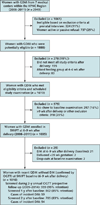Lactation and Progression to Type 2 Diabetes Mellitus After Gestational Diabetes Mellitus: A Prospective Cohort Study
- PMID: 26595611
- PMCID: PMC5193135
- DOI: 10.7326/M15-0807
Lactation and Progression to Type 2 Diabetes Mellitus After Gestational Diabetes Mellitus: A Prospective Cohort Study
Abstract
Background: Lactation improves glucose metabolism, but its role in preventing type 2 diabetes mellitus (DM) after gestational diabetes mellitus (GDM) remains uncertain.
Objective: To evaluate lactation and the 2-year incidence of DM after GDM pregnancy.
Design: Prospective, observational cohort of women with recent GDM. (ClinicalTrials.gov: NCT01967030).
Setting: Integrated health care system.
Participants: 1035 women diagnosed with GDM who delivered singletons at 35 weeks' gestation or later and enrolled in the Study of Women, Infant Feeding and Type 2 Diabetes After GDM Pregnancy from 2008 to 2011.
Measurements: Three in-person research examinations from 6 to 9 weeks after delivery (baseline) and annual follow-up for 2 years that included 2-hour, 75-g oral glucose tolerance testing; anthropometry; and interviews. Multivariable Weibull regression models evaluated independent associations of lactation measures with incident DM adjusted for potential confounders.
Results: Of 1010 women without diabetes at baseline, 959 (95%) were evaluated up to 2 years later; 113 (11.8%) developed incident DM. There were graded inverse associations for lactation intensity at baseline with incident DM and adjusted hazard ratios of 0.64, 0.54, and 0.46 for mostly formula or mixed/inconsistent, mostly lactation, and exclusive lactation versus exclusive formula feeding, respectively (P trend = 0.016). Time-dependent lactation duration showed graded inverse associations with incident DM and adjusted hazard ratios of 0.55, 0.50, and 0.43 for greater than 2 to 5 months, greater than 5 to 10 months, and greater than 10 months, respectively, versus 0 to 2 months (P trend = 0.007). Weight change slightly attenuated hazard ratios.
Limitation: Randomized design is not feasible or desirable for clinical studies of lactation.
Conclusion: Higher lactation intensity and longer duration were independently associated with lower 2-year incidences of DM after GDM pregnancy. Lactation may prevent DM after GDM delivery.
Primary funding source: National Institute of Child Health and Human Development.
Conflict of interest statement
Authors not named here have disclosed no conflicts of interest. Forms can be viewed at www.acponline.org/authors/icmje/ConflictOfInterestForms.do?msNum=M15-0807.
Figures
Comment in
-
Breast feeding may cut risk of diabetes in high risk women.BMJ. 2015 Nov 23;351:h6255. doi: 10.1136/bmj.h6255. BMJ. 2015. PMID: 26603979 No abstract available.
-
Lactation and Progression to Type 2 Diabetes Mellitus After Gestational Diabetes Mellitus.Ann Intern Med. 2016 Aug 16;165(4):299. doi: 10.7326/L16-0105. Ann Intern Med. 2016. PMID: 27538168 No abstract available.
-
Lactation and Progression to Type 2 Diabetes Mellitus After Gestational Diabetes Mellitus.Ann Intern Med. 2016 Aug 16;165(4):299-300. doi: 10.7326/L16-0106. Ann Intern Med. 2016. PMID: 27538169 Free PMC article. No abstract available.
Summary for patients in
-
Summaries for patients. Lactation and Progression to Type 2 Diabetes After Gestational Diabetes.Ann Intern Med. 2015 Dec 15;163(12). doi: 10.7326/P15-9038. Epub 2015 Nov 24. Ann Intern Med. 2015. PMID: 26595877 No abstract available.
References
-
- Bellamy L, Casas JP, Hingorani AD, Williams D. Type 2 diabetes mellitus after gestational diabetes: a systematic review and meta-analysis. Lancet. 2009;373:1773–1779. [PMID: 19465232] - PubMed

